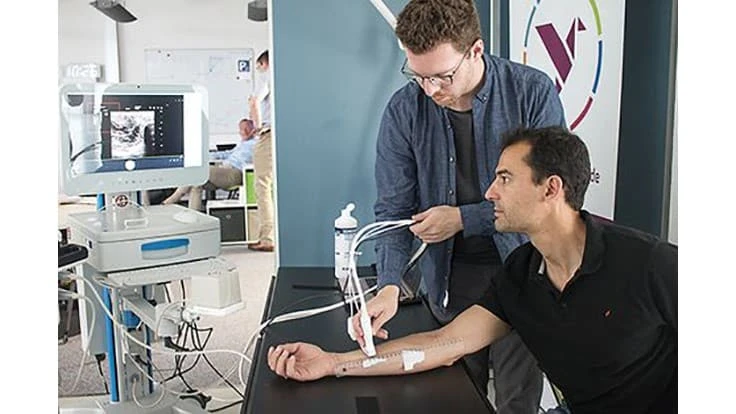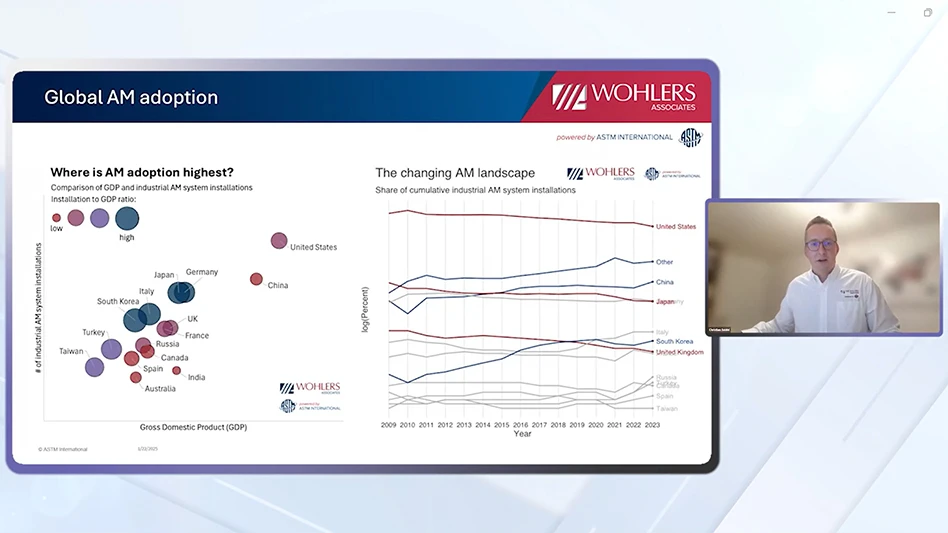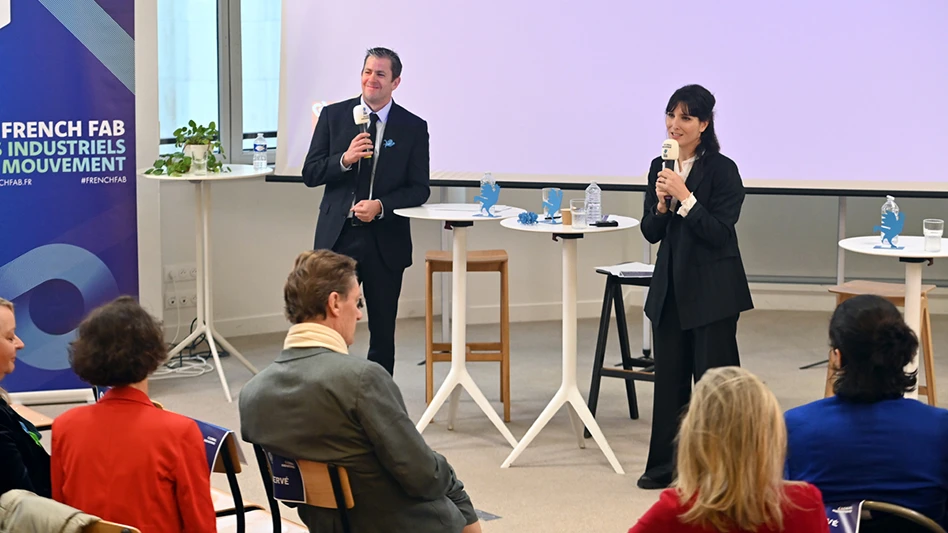
©IMG Saxony-Anhalt
The INKAs, from the Chair for Intelligent Catheters at the Otto-von-Guericke-University Magdeburg, are making a name for themselves with award-winning innovations for image-based therapies. Their in-house InnoLab IGT (Image Guided Therapy laboratory) is a close companion from the initial idea through to the start-up.
With the laparoscope in his left hand and an instrument with miniature forceps at the tip in his right hand, Medical Engineer Thomas Sühn navigates both through the abdomen of a phantom reproduction of the human body and looks at the screen. The feeling for whether the therapeutic part of the instrument is actually located in the target tissue is controlled by an intelligent needle system: the SURgical Audio Guide, or SURAG for short, recognizes the acoustic signals of the human body. The technology measures the interactions between the human tissue and the biopsy needle through an accessory at the end of the instrument which records sound from the tissue structures. The expert on the signal analysis is Dr. Alfredo Illanes. He and doctoral student Thomas Sühn are members of INKA – the research group of the Chair for Intelligent Catheters – Catheter Technologies and Image-Controlled Therapy at Otto von Guericke University Magdeburg. Michael Friebe, an expert in magnetic resonance imaging and other imaging technologies, holds the professorship, which is financed by companies in the regional economy.
His INKA team, consisting of young junior scientists, has succeeded in becoming a multiple award-winning advanced grouping for the development of components and complete systems for minimally invasive surgical techniques, as well as for areas of application in the areas of medical imaging and micro-systems technology.
A team of scientists has just been awarded the 2019 IQ Innovation Prize for Central Germany. They developed the contrast medium injector EasyJector for imaging diagnostics. The new device is small, lightweight, and controlled by an app, and patients can wear it on their arm even in close proximity to the magnetic resonance scanner (MRI).
“Contrast medium injections could be 1,000x cheaper with the EasyJector,” says Michael Friebe, explaining that the current objective is to place the device on the medical technology market.
The companion along this path is an innovation and start-up laboratory, the likes of which we have only seen from the creative industries. The InnoLab IGT (Image Guided Therapy) was initiated by the INKA Chair.
The Innovation Incubator
“We want to link ideas and people,” explains INKA Professor Friebe, saying that the InnoLab IGT provides assistance in analysing the need for start-up ideas. In the further course of the project, the participating stakeholders can build their models here in the prototype laboratory and test them in interaction with various medical robots in the simulation OR.
Friebe is currently in talks with an interested party who wants to take the EasyJector to the Scandinavian market. They have to provide the certifications required by law, develop a business model, found a start-up... These are just a few of the preparatory steps that the InnoLab IGT assumes responsibility for – roughly ten percent of the total costs until a medical technology product is on the market, Friebe highlights.
With their SURgical Audio Guide, Thomas Sühn and Alfredo Illanes are among those who want to entrepreneurs. In 2017, the INKAs were awarded a prize in the Hugo-Junkers competition of the federal state of Saxony-Anhalt in the category of the Most Innovative Projects in Basic Research. The INKA-InnoLab is supporting them in the further development of SURAG. The audio signal must be translated by information technology so that the doctor can interpret it effectively during an operation. At the same time, Thomas Sühn and Alfredo Illanes are being accompanied in the founding of their start-up company.
Prototype tests in the InnoLab
Sinja Lagotzki and Juan Sebastián Sánchez López from the INKA team have now been “entrepreneurs” for a few months. Their start-up. “In-Line” produces new MR-compatible tools, including the corresponding software. This new generation of tools, which work precisely and efficiently in the MRI environment, aims to help physicians to perform minimally invasive treatments, also in the narrow tube of the magnetic resonance scanner – safely, conveniently and quickly. “In-Line” is currently developing tools for pain therapy in the spine. Thanks to the demonstrations in the InnoLab IGT simulation operating theatre (OT), the start-up company can be certain of demand.
“Both researchers and clinical users, but also industrial manufacturers can test our prototypes on site,” explains INKA Professor Friebe. The equipment of the simulation OT includes, among others, reproductions of the human body called “Phantom”, an operating table, a 3D-C arm, an endoscopy tower, various medical robots and ultrasound tomography devices.
One of these state-of-the-art devices is a prize that was awarded directly by the American medical technology company General Electric Healthcare for projects relating to liver health. An INKA research group joined the competition with its method of ultrasound-guided monitoring of the temperature propagation in human tissue.
“It is difficult to distinguish a tumor from the surrounding healthy tissue. The image analysis which we have developed enables us to identify the tumour and plan the targeted destruction at a temperature of at least 60 degrees Celsius,” explains Medical Engineer Jens Ziegle. The doctoral student provided the ideas for the procedure.
Award-winning healthcare solutions
A new ultrasound device from the company piur imaging GmbH is currently being installed in the INKA-InnoLab. The Austrian company intends to enhance ultrasound devices with an additional function which combines several ultrasound images to create a 3D image. The INKAs are participating in this EU research project.
The outstanding importance of this innovation laboratory for the medical technology industry is underscored not least by the renowned membership of the globally active InnoLab IGT Industry Advisory Board. In addition to piur imaging GmbH, global players such as Olympus Surgical Technologies Europe (Olympus Winter & Ibe GmbH), Brainlab AG, Surgiceye GmbH and the local Primed GmbH are also represented.
At the end of the day, Professor Friebe posts the latest news: medical technology company Siemens Healthineers is awarding two prizes to developments that the INKAs “... have put on the path to becoming a provider of innovative healthcare solutions.”
Latest from Today's Medical Developments
- Methods Machine Tools, Multiaxis, announce AI solution investment
- MGS to showcase global expansion and healthcare CDMO expertise
- Medtronic: 5 healthcare tech trends for 2025
- Norman Noble launches enhanced laser welding capabilities; expands micromachining in Florida
- What you need to know about CMMC requirements
- CO2 footprint of a machine tool
- Ainos unveils AI Nose for robotics
- Keep up with the latest in design and manufacturing through free webinar





